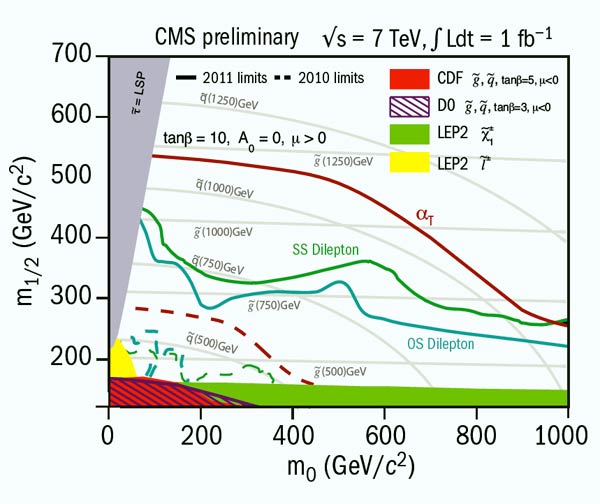EPS-HEP 2011
In this issue, news from the LHC experiments focuses on a few highlights at the first big summer conference.

The CMS collaboration contributed more than 30 new or updated physics analyses at EPS-HEP 2011. The most eagerly awaited results probably concerned searches for the Higgs boson as well as for new physics beyond the Standard Model. A highly anticipated search is the one for supersymmetry (SUSY), and the corresponding search for the production of new heavy supersymmetry particles. If SUSY exists in nature at the tera-electron-volt scale, it could solve many of the outstanding issues in particle physics, such as the gauge hierarchy problem. It could also deliver a natural candidate particle to explain the high density of dark matter in the universe.
The CMS collaboration released several new analyses at EPS-HEP 2011 on the search for SUSY, based on the full data sample of about 1 fb–1 at 7 TeV in the centre-of-mass, collected by the end of June 2011 and analysed in time for the conference. These analyses search for a variety of characteristic event final-state topologies: e.g. events with a large missing transverse momentum plus either only jets, or leptons and jets. Techniques already used to analyse the 2010 data sample, based on 30 times less data, were further refined and used with the 2011 data.
The results are remarkable, testing regions in the parameter space of SUSY theory where the squarks and gluinos (the supersymmetric partners of quarks and gluons) can be as heavy as 1 TeV. Unfortunately there is no sign so far of the production of SUSY particles. With these latest results, CMS has substantially reduced the phase space where SUSY can hide, particularly in the so-called constrained models such as the Constrained Minimal Supersymmetric extension of the Standard Model (CMSSM). Figure 1 illustrates the impressive reach of the CMS analyses with respect to other experiments in the plane of the universal scalar and gaugino masses at the GUT scale (m0 and m1/2, respectively) of the CMSSM.

The collaboration has also released its first paper based on the 2011 dataset of 1 fb–1, namely on the search for very high mass resonances in events that have at least two jets with a large transverse momentum in the final state. Jets are observed in the detectors as sprays of particles ejected from the interaction point in a given direction – that is, the direction of the original parton produced in the hard scattering of the collision, or in the decay of a heavy new particle. Examples of possible heavy new particles that can be studied in such di-jet invariant mass analyses are new gauge bosons, graviton resonances, string resonances, and more exotic objects that couple via the strong force, such as axigluons or colour octet states. Each one of these particles is predicted in one or more models for new physics beyond the Standard Model.
CMS has now examined the di-jet mass for mass values up to 4 TeV. No significant sign of di-jet resonances has been found and, as figure 2 shows, various other new particles have now been excluded in the range of 1–4 TeV, depending on the model and particle species.
The search for SUSY and other new physics signatures at the LHC is in a very early stage – an important increase in luminosity is expected before the end of 2012. These first data are beginning to disfavour the simplest and more constrained models, but the range of possibilities that need to be explored further is vast. As David Gross said in the concluding remarks at the conference: “Nobody promised it would be easy.”
Further reading
CMS-SUS-11-003 and arXiv:1107.4771.







